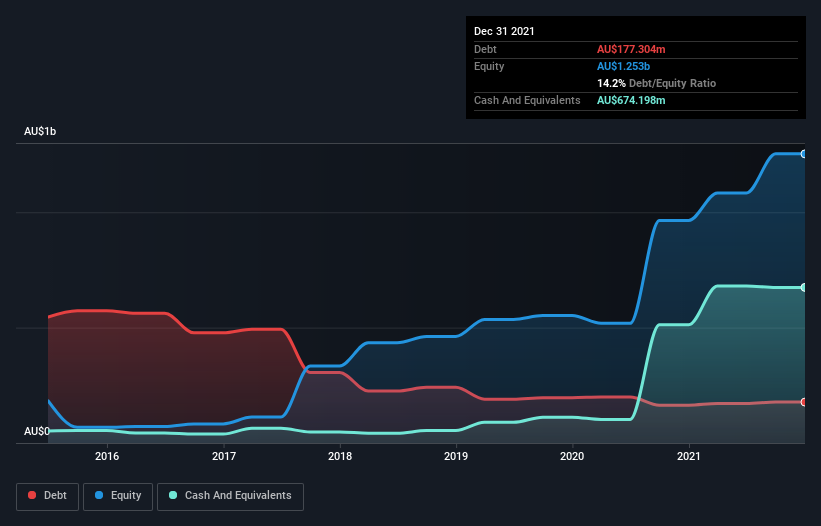Is Lynas Rare Earths (ASX:LYC) Using Too Much Debt?
Legendary fund manager Li Lu (who Charlie Munger backed) once said, 'The biggest investment risk is not the volatility of prices, but whether you will suffer a permanent loss of capital.' So it seems the smart money knows that debt - which is usually involved in bankruptcies - is a very important factor, when you assess how risky a company is. As with many other companies Lynas Rare Earths Limited (ASX:LYC) makes use of debt. But the more important question is: how much risk is that debt creating?
When Is Debt A Problem?
Debt and other liabilities become risky for a business when it cannot easily fulfill those obligations, either with free cash flow or by raising capital at an attractive price. Part and parcel of capitalism is the process of 'creative destruction' where failed businesses are mercilessly liquidated by their bankers. While that is not too common, we often do see indebted companies permanently diluting shareholders because lenders force them to raise capital at a distressed price. Having said that, the most common situation is where a company manages its debt reasonably well - and to its own advantage. When we think about a company's use of debt, we first look at cash and debt together.
See our latest analysis for Lynas Rare Earths
What Is Lynas Rare Earths's Debt?
The image below, which you can click on for greater detail, shows that at December 2021 Lynas Rare Earths had debt of AU$177.3m, up from AU$163.7m in one year. However, its balance sheet shows it holds AU$674.2m in cash, so it actually has AU$496.9m net cash.
How Strong Is Lynas Rare Earths' Balance Sheet?
We can see from the most recent balance sheet that Lynas Rare Earths had liabilities of AU$121.4m falling due within a year, and liabilities of AU$271.0m due beyond that. On the other hand, it had cash of AU$674.2m and AU$102.2m worth of receivables due within a year. So it can boast AU$384.0m more liquid assets than total liabilities.
This short term liquidity is a sign that Lynas Rare Earths could probably pay off its debt with ease, as its balance sheet is far from stretched. Succinctly put, Lynas Rare Earths boasts net cash, so it's fair to say it does not have a heavy debt load!
Better yet, Lynas Rare Earths grew its EBIT by 1,762% last year, which is an impressive improvement. That boost will make it even easier to pay down debt going forward. The balance sheet is clearly the area to focus on when you are analysing debt. But ultimately the future profitability of the business will decide if Lynas Rare Earths can strengthen its balance sheet over time. So if you're focused on the future you can check out this free report showing analyst profit forecasts.
Finally, while the tax-man may adore accounting profits, lenders only accept cold hard cash. Lynas Rare Earths may have net cash on the balance sheet, but it is still interesting to look at how well the business converts its earnings before interest and tax (EBIT) to free cash flow, because that will influence both its need for, and its capacity to manage debt. During the last three years, Lynas Rare Earths produced sturdy free cash flow equating to 73% of its EBIT, about what we'd expect. This cold hard cash means it can reduce its debt when it wants to.
Summing up
While we empathize with investors who find debt concerning, you should keep in mind that Lynas Rare Earths has net cash of AU$496.9m, as well as more liquid assets than liabilities. And we liked the look of last year's 1,762% year-on-year EBIT growth. So we don't think Lynas Rare Earths's use of debt is risky. The balance sheet is clearly the area to focus on when you are analysing debt. However, not all investment risk resides within the balance sheet - far from it. For example - Lynas Rare Earths has 1 warning sign we think you should be aware of.
When all is said and done, sometimes its easier to focus on companies that don't even need debt. Readers can access a list of growth stocks with zero net debt 100% free, right now.
Have feedback on this article? Concerned about the content? Get in touch with us directly. Alternatively, email editorial-team (at) simplywallst.com.
This article by Simply Wall St is general in nature. We provide commentary based on historical data and analyst forecasts only using an unbiased methodology and our articles are not intended to be financial advice. It does not constitute a recommendation to buy or sell any stock, and does not take account of your objectives, or your financial situation. We aim to bring you long-term focused analysis driven by fundamental data. Note that our analysis may not factor in the latest price-sensitive company announcements or qualitative material. Simply Wall St has no position in any stocks mentioned.

 Yahoo Movies
Yahoo Movies 

